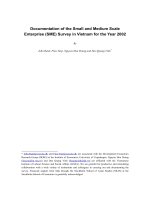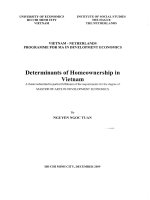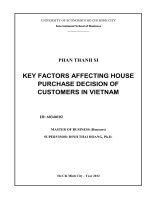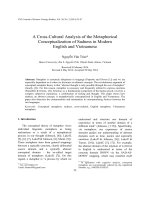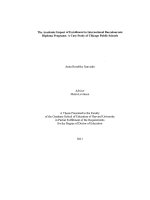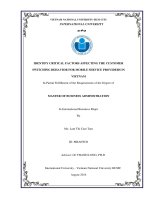DescribeCalculate the wetland hydrology of different types of Wetlands in Vietnam
Bạn đang xem bản rút gọn của tài liệu. Xem và tải ngay bản đầy đủ của tài liệu tại đây (361.37 KB, 17 trang )
VNU University Of Science - 334 Nguyen Trai –Thanh Xuan – Hanoi
Faculty of Environment- Environmental Technology
Group working: Wetland
Topic:
Describe/Calculate the wetland hydrology of different types
of Wetlands in Vietnam
Group 3
: Cù Thị Hiền, Nguyễn Thị Hương, Nguyễn Văn Luân,
Nguyễn Ngọc Khánh, Vũ Thị Bích Ngọc
Instructors
: Nguyễn Thị Loan
Calculate/describe the wetland hydrology in different types of Vietnam wetlands
Page 1
Hanoi, 10th May 2013
Abstract
Hydrology is the force that drives wetland soil development and biotic process, regulates sediment
deposition, plant productivity and organic matter accumulation. Hydrology is probably the single
most important determinant of the establishment and maintenance of specific types of wetlands and
wetland processes. This studying purpose is to describe general hydrologic properties, and to
provide an overview of the processes that control wetland hydrologic behavior. Based on these
properties, the study will describe and calculate the wetland hydrology of specific types of Wetland
in Vietnam to deeply understand about hydrology of specific types of Wetlands in Vietnam
I.
Introduction
The purpose of this study is to describe, calculate and discuss the general hydrologic properties
that make wetlands unique, then to provide calculation of specific different wetlands in Vietnam
that classified base on the Vietnam wetland classification system. Firstly, this studying gives a
general definition of hydrology to have a hydrologic overview. Hydrology is all hydrologic
characteristics of area that are periodically inundated or have soils saturated to the surface at
sometimes during the grow season. Hydrology is probably the single most important determinant
of the establishment and maintenance of specific types of wetlands and wetland processes.(Mitsch
and Gosselink (1993)). Therefore, discussion and calculation wetland hydrology are very important
for understanding how much water is stored, how all components determine amount of water in
the each types of wetland in Vietnam, and lead to the balance of inflows and outflows. If the need
arises to obtain more specific information, the reader is advised to refer to wetland books or
articles, including those referenced within this study.
Calculate/describe the wetland hydrology in different types of Vietnam wetlands
Page 2
II.
Study Methodology
To calculate and describe hydrology of different wetland in Vietnam, this study will firstly give all
components that affect indirectly or directly the water budget and water balance in wetlands with
formulas and description respectively. Besides, it is very important to contribute a complete
equation describing the balance of all components that is known as water budget. Next, this study
will show the way to classify Vietnam wetland system based on the Vietnam wetland classification
system, then giving specific wetlands in Vietnam relative to each systems, subsystems and classes
and leading to calculate and describe hydrology of different chosen wetlands are final purposes in
this study. Moreover, in order to describe and calculate correctly, data collection relating to
hydrological properties is so essential for each chosen Vietnam wetland including: Da river, Tra O
marsh, Ba river delta, Ba Lat mouth, Can Gio mangrove forest. Because the information and data
are not enough to calculate the water budget of Can Gio mangrove forest, this wetland just is
described about hydrological factors. This study methodology is clear and simple to get approaches
of study purpose.
1.
General
Hydrologic conditions and their simple determinations, such as hydroperiod, water budget and so
on, in wetland studies can contribute to a better understanding of wetland function. The wetland
hydroperiod is the seasonal pattern of water level of a wetland. It defines the rise and fall of a
wetland’s surface and subsurface water. For wetlands that are not subtidal or permanently flooded,
the amount of time that a wetland is in standing water is called the flood duration, and the average
number of times that a wetland is flooded in a given period is known as the flood frequency. The
hydroperiod is not the same each year but varies statistically according the climate and previous
conditions.
The balance of inflows and outflows of water through a wetland defines the water budget and
determines the amount of water stored within the wetland. The major components of a wetland’s
Calculate/describe the wetland hydrology in different types of Vietnam wetlands
Page 3
water budget include precipitation, evapotranspiration, flooding in riparian wetlands, surface
flows, groundwater, tides in coastal wetlands. The water level fluctuations are also determined by
level of development, changes in activities and so on.
2. Hydrological components
2.1. Precipitation
Wetlands occur most extensively in regions where precipitation, a term that includes rainfall and
snowfall, is in excess of losses such as evapo-transpiration and surface runoff. Some of
precipitation will be retained by the vegetation cover that is called interception (I). The total
amount of precipitation that actually reaches the water’s surface or substrate of a wetland is called
the net precipitation (Pn) and is defined as
Pn = P – I
(1)
2.2. Surface Water
Surface Runoff Wetlands are subjected to surface inflows of several types. Overland flow is nonchannelized flow that usually occurs during and immediately following rainfall or as tides rise in
coastal wetlands and so on. A wetland influenced by a drainage basin may receive channelized
stream-flow during most or all of the year. Wetlands are often an integrated part of a stream or
river. Surface inflow from a drainage basin into a wetland is usually difficult to estimate without a
lot of data. The direct runoff component of stream-flow refers to rainfall during a storm that causes
an immediate increase in stream-flow. An estimate of the amount of precipitation that results in
direct runoff from an individual storm can be determined from the following equation:
Si = RPPAw
(2)
where Si = direct surface runoff into wetland (m3 / storm event)
RP = hydrologic response coefficient
P = average precipitation in watershed (m)
Calculate/describe the wetland hydrology in different types of Vietnam wetlands
Page 4
Aw = area of watershed draining into wetland (m2)
-
The value of RP, which represent the fraction of precipitation in the watershed that becomes
-
direct runoff, for example, range from 4-18% for small watersheds in the eastern U.S.
In some cases, peak runoff or flood peak may be important. An useful way to predict peak
runoff for only small watersheds less than 80 ha in size, is calculation by using the
following equation:
Si(pk) = 0.278CIAw
(3)
where Si(pk) = peak runoff into wetland (m3 / s)
C = rational runoff coefficient
I = rainfall intensity (mm / h)
Aw = area of watershed draining into wetland (km 2)
The coefficient C, which ranges from 0 to1, depends on the upstream land use. Concentrated
urban areas have a coefficient ranging from 0.5 to 0.95, and the rural areas have lower coefficients
that greatly depend on soil type, with sandy soils lowest (C = 0.1-0.2) and clay soils highest (C =
0.4-0.5).
Stream-flow The water that flows down river courses is obtained from either surface runoff
of rainfalls and snowmelt from catchments. In order to obtain the water discharge in wetland from
channel, flow rates must be measured.
Most measurements for flow rates depend on following
equation:
Q = AV
(4)
Where Q = discharge or volume per unit time
A = cross-sectional area of flow
V = mean velocity of flow through the cross-section
2.3. Groundwater
Calculate/describe the wetland hydrology in different types of Vietnam wetlands
Page 5
Groundwater inflow results when the surface water (or groundwater) level of a wetland is lower
hydrologically than the water table of the surrounding land (called a discharge wetland). When the
water level in a wetland is higher than the water table of its surroundings, groundwater will flow
out of the wetland (called a recharge wetland).
It is increasingly recognized that groundwater plays an important role in the water balance, water
quality and ecology of surface water bodies. Along with that realization, there has been much
progress in recent years in the detection and measurement of groundwater discharge to surface
water (and of groundwater recharge from surface water). These include physical methods such as
stream gauging and seepage meters, chemical and isotope methods for hydrograph separation and
for determining groundwater inflow, thermal methods for detecting groundwater flow, and
continuing advances in hydro(geo)logical instrumentation. However, conceptual, theoretical and
technical challenges remain. Water movement at the margins of surface water generally involves a
complex and constantly changing interaction between regional groundwater flow, local saturated
and unsaturated subsurface flow, surface water fluctuations, root uptake and evapo-transpiration.
2.4. Evapo-transpiration
Several direct measurement techniques can be used in wetlands to determine evapo-transpiration.
The classical reference method is the measurement of evaporation from a water-filled pan , usually
by measuring the weight loss, by measuring the volume required to replace lost water over a period
of time, or by measuring the drop of water level.
3. Water Budget and Water Balance
The hydroperiod, or hydrologic state of a given wetland, can be summarized as being a result of
the following factors:
1. The balance between the inflows and outflows of water
2. The surface contours of the landscape
3. Subsurface soil, geology, and groundwater conditions
Calculate/describe the wetland hydrology in different types of Vietnam wetlands
Page 6
The first condition defines the water budget of the wetland. The second and the third define the
capacity of the wetland to store water. The general balance between water storage and inflows and
outflows, illustrated in Figure 1, is expressed as
∆V/∆t = Pn + Si + Gi – ET – So – Go ± T
(5)
where V = volume of water storage in wetlands
∆V/∆t = change in volume of water storage in wetland per unit time, t
Pn = net precipitation
Si = surface inflows, including flooding streams
Gi = groundwater inflows
ET = Evapotranspiration
So = surface outflows
Go = groundwater outflows
T = tidal inflow (+) or outflow (-)
Each of the terms in equation (1) can be expressed in terms
of depth per unit time (e.g., cm / year) or in terms of volume per unit time (e.g., m3 / year)
The average water depth, d, at any one time, can further be described as
d=V/A
(6)
where A = wetland surface area
Figure 1. Generalized water budget for a wetland with corresponding terms as in equation 5
Calculate/describe the wetland hydrology in different types of Vietnam wetlands
Page 7
4. The Vietnamese Wetlands Classification System
The following Table 1 illustrates this classification structure. Here, the term “system” refers to a
collection of wetlands that share the influence of the salinity of water and marine factors.
Therefore, wetlands are divided into 2 systems: coastal and inland wetlands. We further divide
“system” into subsystems based on origin of wetlands, due to human activities or natural
processes. Thus, a system is divided into two subsystems: Natural wetlands and Artificial
wetlands. The class is determined based on the hydrological condition. As a result, a subsystem is
divided into two classes: permanent and nonpermanent saturation.
Calculate/describe the wetland hydrology in different types of Vietnam wetlands
Page 8
Calculate/describe the wetland hydrology in different types of Vietnam wetlands
Page 9
List of name of chosen different wetlands in Vietnam
System
Inland
Wetland
Sub-system
Natural
wetland
Coastal
Wetland
Artificial
wetland
Natural
wetland
Class
Permanent
Nonpermanent
Nonpermanent
Permanent
Name
Da River
Tra O Marsh
Rice field( Ba river Delta)
Ba Lat Mouth
Can Gio Mangrove Forest
III.
1.
Result of study
Da River
The Black River sub-basin in Vietnam have territorial catchment area is 25,200 km 2. The total
amount of water flowing into the basin from
outside: 26 million m3 per year, annual rainfall
across the basin: 50 million m3 per year, the
total evaporation over an area of 24 million m3
per year, total local flow and outside is about
52 million m3 per year, 25 million m3 per year
for outflow. It can be said the water resources
in the Black River sub-basin is rich, the rivers
and streams of the Black River sub-basin with
high slopes create the largest hydropower potential in Vietnam's rivers, accounting for 35% of total
potential hydropower of the country.
The water budget can be shown by
= Pn + Si + Gi – ET – So
Calculate/describe the wetland hydrology in different types of Vietnam wetlands
Page 10
= 50x106 + 26x106 + 26x106 – 24x106 – 25x106
= 53x106 (m3/year)
2.
Tra O Marsh
Tra O Marsh is located in Phu My- Binh Dinh, and is built up a remarkable area of wetland
ecology for Binh Dinh. Tra O mash has an abundant water resource, provides water for My Thang,
My Loi, My Duc commons in Phu My district for agriculture and a large amount of aquatic
products for local people.
Tra O Marsh has a large scale of precipitation, average amount of precipitation is around
1900mm/year. Precipitation in 3 months of growing season (September, October and November)
accounted to be P = 1233 mm and take about 65% of rainfall in this year.
Month
Precipitatio
n
Evaporation
Flow
1
2
3
4
5
43 10.5
6.1 27.7
75.3 61.7 75.3 73.4
-32.3 -51.2 -67.4 -45.7
97.8
92.1
5.7
6
7
8
9
10
11
12
146 67.5
112 122
34 -54.5
115
142
-27
249
84.3
164
560
73.1
487
424
61.8
362
152
69.4
82
Phu My is located near the East sea, so it has a large scale of precipitation and also a high
amount of inflow in growing season. In growing season:
F= (164 + 487 + 362) =1013( mm).
Then the storage balance can be illustrated by:
= P-ET+F = 1233- 219.2+ 1013 = 2026.8 (mm/3months) = 675.6 (mm/month).
Calculate/describe the wetland hydrology in different types of Vietnam wetlands
Page 11
With this high amount of adding water in water budget, it is easy to cause flood in growing
period.
Opposite with growing season, in the dry season (January, February and April), the
precipitation is very low with P= 59.6 mm (only 3.14% of total precipitation of a year) and the
outflow is significant with F= -150.9 mm. Besides, the temperature in this season is lower and
humidity is higher than this in dry season, lead to reduce evaporation rate. Therefore, the
change in water budget has the minus number.
= P-ET+F = 59.6 – 150.9 -213.3 = - 334.6 mm/3months = -111.56 mm/ month.
That explained why Tra O Marsh has area of 1.200 ha in dry season and spreading out to 1600 ha
in growing season.
Although Tra O Marsh has a long dry season (from January to August), but Tra O receives
quietly a high amount of precipitation and run-off flow, so the water storage average in a
year is still quite high.
= P-ET+F = 1900- 1042.4 + 856.6 = 1712.8 mm/year
3.
Ba Lat Mouth
BaLat estuary lies in the area governed both by flood and tides, and the area essentially controlled
by the tidal regime .One of the main hydrological characteristics of the river mouth is the behavior
of the river water during the dry and flood seasons .From current data during the flood and dry
seasons of 2000,it appears that the outflow lasts longer than the inflow, especially during the flood
season(outflow 19h,inflow–6h;respective maximum velocities : 1.2m/s to 0.4m/s).
The interface between saline and freshwater depends on the river flow, the tidal cycle and the
river morphology.
Calculate/describe the wetland hydrology in different types of Vietnam wetlands
Page 12
During the dry season, the out flow (river flow plus ebb-tide flow) were 0.45m/s during spring
tides and 0.25m/s during neap tide. the inflow were 0.25m/s during spring tides and 0.0 during
neap tides .During the flood season , outflow velocity reach 1.2m/s ,and the outflow is permanent
during both neap and spring tides. The tide at the BaLat mouth is varying from 1.9 to 2.6m
Average water discharge through the BaLat mouth is about 300m 3 /s in dry and 3500m3/s during
flood seasons
Each year, the Red river discharge about 137×10 9 m3 of water and distributes 25% of the flow of
the Red River discharging into the sea via the Ba Lat mouth. There for the annual discharge of Ba
Lat mouth is 137×109 × 25% = 3.425 × 1010m3.
4.
Rice field
Delta is in Ba river‘s downstream. This is the largest delta in Central South Area of about 500km 2.
Rice field is an artificial wetland, so the inflow and outflow are stopped in order to control water
budget in rice field. The income water is depend on rainfall and irrigation, and the outcome are
regulated by evapotranspiration and percolation through soil structure (DP)
The following table shows all water budget components in the Ba river Delta
Calculate/describe the wetland hydrology in different types of Vietnam wetlands
Page 13
Water budget in rice field is largely depend on irrigation and percolation, the rainfall is not the
main source of hydrology as other wetlands
The change in water budget can be illustrated by following equation :
= Pn +Ir – ET - DP
= (18.15 ×106 + 520.7 ×106 – 134.6 ×106 – 333.85 ×106)
= 70.40×106 m3/3.5months = 20.11×106 m3/month
5.
Can
Can
Gio Mangrove Forest
Gio
mangrove forest lies entirely
within the Can
Gio district of Ho Chi Minh
City. It covers an area of 75740 ha in 2012. Mangrove areas account for 56.7% of the total area
(42944.6 ha).
•
Precipitation: Precipitation (P) in Can Gio is the lowest in the Ho Chi Minh City area, with
an average range of 1300 – 1400 mm per annum. In 2012, the average rainfall is 1336 mm a
year.
• Humidity and evapo-transpiration
The humidity in Can Gio is about 4% - 8% higher than in other areas of Ho Chi
Minh City. During the rainy season, humidity ranges from 79% - 83%, with a
maximum of 83% in September. In the dry season, humidity ranges from 74%-77%,
with a minimum of 74% in April.
Calculate/describe the wetland hydrology in different types of Vietnam wetlands
Page 14
The average extent of evaporation is 4 mm/day, and 120.4 mm/month. Evaporation
is at its highest in June (173.2 mm/month) and at its lowest in September (83.4
•
mm/month).
Tidal inflows and outflows
The Can Gio mangrove forest lies in a zone with a irregular semi-diurnal tidal regime (i.e. two
times ebb and flow tides per day). Tidal amplitudes range from about 2 m at mean tide to 4 m
during spring tides. It has been observed that the two daily high and low tides differ in height.
Maximum tidal amplitudes, in the region of 4.0 – 4.2 m are the highest observed in the whole of
Viet Nam. Tidal amplitude decreases with distance north (i.e. inland), relating to the proximity of
the Bien Dong Sea (South China Sea). High tides reach their maximum between September and
January, at 3.6 - 4.1 m in the southern and 2.8 - 3.3 m in the northern regions of Can Gio. In Can
Gio, the maximum high tide occurs in October or November, and the minimum in April or May.
According to lunar calendar, between the 29th and 3rd day of the month and between the 14th and
18th day of the month, the whole of the Can Gio mangrove forest is flooded at high tide (twice a
day). On the 8th and 25th day of the month (lunar calendar) the low tide is at its minimum.
IV. Conclusion
Hydrology is probably the single most important determinant of the establishment and
maintenance of specific types of wetlands and wetland processes. Depending on the topography,
vegetation, climate, sources of water… wetlands in Vietnam is divided into 38 types based on
physiography and composition of substrate features, geomorphologic, geologic features and origin
of wetland. Types of wetland are different in term of hydrology characteristics.
All the calculations in the study base on the equation of water storage in wetland
= Pn + Si + Gi – ET – So – Go ± T
Calculate/describe the wetland hydrology in different types of Vietnam wetlands
Page 15
Depend of the differences of hydrological statistics in different wetlands, the equation can be
calculated with different factors and have different units. Therefore, the results show hydrological
status of given wetlands that are water budget and water stored capacity of wetlands.
Basically, Vietnam lies in tropical weather zone, and has a long coastal area leading to have a large
scale of precipitation and the precipitation is greater than evapotranspiration. The change in water
budget is highly greater than zero. Besides, Vietnam has a higher relief in the western and the
Eastern Sea in the east, the water-flow and tidal are quite the main water sources for some
wetlands.
V. References
1. “Hydrology and morphology of two river mouth regions (temperate Vistula Delta and
subtropical Red River Delta)” Zbigniew Pruszak1 Pham van Ninh2 Marek Szmytkiewicz1
Nguyen Manh Hung2 Rafał Ostrowski1,∗
2. “The Vietnamese Wetlands Classification System ”
Mai Trong Nhuan, Nguyen Thi Thu Ha, Tran Dang Quy, Nguyen Thi Ngoc,
Do Thi Thuy Linh, Nguyen Thi Minh Ngoc, Nguyen Thi Hong Hue, Pham Bao Ngoc
3. “Định hướng qui hoạch sử dụng nước lưu vực Đầm Trà Ô, tỉnh Bình Định” Nguyễn Thanh
Sơn- Khoa khí tượng Thủy văn và Hải dương học Đại học khoa học Tự Nhiên- ĐHQG Hà
Nội
4. “ Wetland Hydrology” The Regional Training Course on
SUSTAINABLE USE AND
MANAGEMENT OF COASTAL WETLANDS 5 – 20 November 2007 Faculty of
Environment and Resource Studies, Mahidol University, Thailand - Kobkaew
Manomaipiboon
Calculate/describe the wetland hydrology in different types of Vietnam wetlands
Page 16



